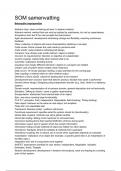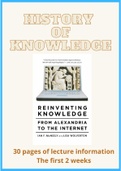Samenvatting
Summary Lecture 1-10 (midterm) - Systeemontwikkelingsmethoden (INFOB2SOM)
- Vak
- Instelling
This summary contains everything you need to know for the midterm exam of Systeemontwikkelingsmethoden (System design methods) (INFOB2SOM). They are based on my lecture notes, and the lecture slides. In case the topics of the course are mixed up in between the exams and you miss something in this s...
[Meer zien]





